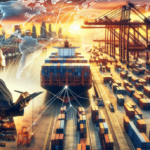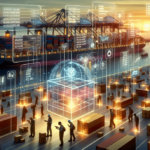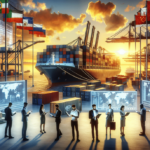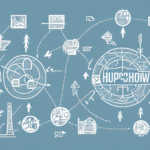What Is Ancillary Clearance Service and How Can It Help Your Business?
In today’s globally connected business landscape, simply manufacturing a product and sending it to the client is no longer sufficient. With numerous international regulations and trade agreements in place, transporting your products across borders can be a complicated and time-consuming process. Often, this process requires the assistance of an ancillary clearance service provider.
The Basics of Ancillary Clearance Services
An ancillary clearance service provider is a third-party logistics company that specializes in customs brokerage, freight forwarding, and other related services. Their primary goal is to help businesses navigate the complex world of international transportation and trade barriers. By hiring an ancillary clearance service provider, you gain access to experts who guide you through the entire clearance process from start to finish.
One of the key benefits of using an ancillary clearance service provider is the potential to save time and money. Leveraging their expertise and industry connections, they can identify the most efficient and cost-effective shipping routes, as well as uncover cost-saving opportunities such as duty drawback programs or free trade agreements. Additionally, they help you avoid costly mistakes and delays by ensuring that all necessary documentation and compliance requirements are met.
The Benefits of Using Ancillary Clearance Services for Your Business
- Time and Cost Savings: Experts handle paperwork efficiently, reducing the risk of delays and fines.
- Peace of Mind: Allows you to focus on other business aspects like marketing and sales.
- Supply Chain Optimization: Provides insights to streamline processes and increase profitability.
- Regulatory Compliance: Ensures adherence to international shipping regulations, avoiding legal issues.
According to a 2023 industry report, businesses utilizing ancillary clearance services experience an average of 30% reduction in shipping delays and a 20% decrease in overall logistics costs.
How Ancillary Clearance Services Can Help You Save Time and Money
Ancillary clearance service providers streamline many logistical processes involved in international trade. For example, they often use electronic data interchange (EDI) systems that facilitate the quick and efficient exchange of information between businesses and customs officials.
Moreover, these providers leverage their relationships with freight carriers and customs officials to negotiate better rates and expedited processing times, helping your business reduce costs and improve delivery speed.
Compliance with complex international trade regulations is another area where ancillary clearance service providers excel. Their expertise ensures your business adheres to all necessary regulations, preventing costly fines and delays.
In the event of shipping issues or delays, ancillary clearance service providers offer valuable support by troubleshooting problems and working with customs officials and freight carriers to resolve issues swiftly, minimizing the impact on your business operations.
Key Features of an Effective Ancillary Clearance Service Provider
When selecting an ancillary clearance service provider, consider the following key features:
- Experience and Knowledge: A strong track record of success in the field.
- Client-Oriented Approach: Excellent communication skills and willingness to collaborate.
- Industry Connections: Robust relationships within the logistics and transportation sectors.
- Supply Chain Optimization: Ability to enhance efficiency and reduce costs.
- Technology Integration: Commitment to leveraging innovative technologies.
- Flexibility and Adaptability: Capability to customize services as your business grows and evolves.
Common Misconceptions About Ancillary Clearance Services Debunked
Several misconceptions can prevent businesses from utilizing ancillary clearance services effectively:
- Only for Large Corporations: Ancillary clearance services are beneficial for businesses of all sizes, not just large multinational corporations.
- Limited to Customs Brokerage: These service providers offer a wide range of logistics and transportation-related services beyond customs brokerage.
- Too Expensive: Many providers offer flexible pricing and customizable packages, making their services affordable for small businesses. Investing in these services can lead to significant cost savings by streamlining logistics and avoiding delays.
Understanding the Role of Customs Brokers in Ancillary Clearance Services
Customs brokers are integral to ancillary clearance services, acting as intermediaries between businesses and customs officials. Their responsibilities include:
- Ensuring all necessary documentation is complete and accurate.
- Facilitating communication between the business and customs officials.
- Determining the correct classification and valuation of goods to prevent overcharging on duties and taxes.
- Providing guidance on compliance with customs regulations and laws.
According to the ShipScience Customs Regulation Guide, effective customs brokers can reduce clearance times by up to 25%, significantly enhancing supply chain efficiency.
The Importance of Compliance in Ancillary Clearance Services
Compliance is a critical element of ancillary clearance services. Failure to comply with customs regulations can result in hefty fines and legal consequences. Therefore, it's essential to work closely with your ancillary clearance service provider to ensure full compliance with all regulations and requirements.
Effective providers have established compliance programs and offer regular updates and training to keep businesses informed about regulatory changes.
Compliance not only helps avoid penalties but also builds trust and credibility with customers and partners. Proper handling and transportation of goods, including adherence to regulations for hazardous materials and accurate labeling and packaging, are vital for safety and legal adherence.
A Step-by-Step Guide to Choosing the Right Ancillary Clearance Service for Your Business
- Identify Your Needs and Goals: Determine the types of goods you will ship, shipment volume, and preferred transportation modes.
- Research Potential Providers: Evaluate their experience, reputation, and range of services. Check references and verify their track record.
- Consultation: Schedule meetings with top choices to discuss their processes, pricing, and approach to ensure alignment with your business needs.
For more detailed guidance, refer to the ShipScience Guide to Choosing Clearance Services.
How Technology is Revolutionizing the Ancillary Clearance Service Industry
Technology is transforming the ancillary clearance service industry by enhancing efficiency and accuracy. Innovations include:
- Electronic Data Interchange (EDI) Systems: Streamline information exchange between businesses and customs officials.
- Artificial Intelligence and Machine Learning: Identify potential compliance issues proactively by analyzing vast data sets.
- Blockchain Technology: Enhances transparency and security in supply chain transactions.
These technologies not only improve operational efficiency but also reduce the likelihood of human error, thereby ensuring smoother clearance processes.
Case Studies: Real-Life Examples of Businesses That Have Benefitted from Ancillary Clearance Services
Consider the case of XYZ Corporation, a mid-sized manufacturer that expanded its exports to a new market. Initially, the company struggled with the necessary documentation and compliance requirements. After partnering with an ancillary clearance service provider, XYZ Corporation was able to streamline its operations, resulting in faster market entry and increased sales by 15% within the first year.
Another example is ABC Electronics, which utilized ancillary clearance services to optimize its supply chain. By identifying more efficient shipping routes and leveraging duty drawback programs, ABC Electronics reduced its logistics costs by 20%, significantly boosting its profit margins.
Top Trends to Watch Out for in the Ancillary Clearance Service Market
The ancillary clearance service market is evolving with several key trends:
- Growth of E-Commerce: The surge in online shopping is creating new opportunities for businesses to reach global markets.
- Sustainability and Environmental Responsibility: Providers are adopting eco-friendly solutions like alternative fuel vehicles and carbon offset programs to meet the growing demand for sustainable logistics.
- Increased Use of Technology and Automation: Technologies such as AI, robotics, and blockchain are enhancing efficiency, reducing costs, and improving the overall customer experience.
Staying informed about these trends can help businesses adapt and leverage the latest advancements in ancillary clearance services.
The Bottom Line
Ancillary clearance services are invaluable for businesses of all sizes, offering significant savings in time and money, ensuring compliance, and streamlining logistical processes. By selecting the right service provider and keeping abreast of the latest industry trends and technologies, businesses can maintain a competitive edge and thrive in an increasingly globalized marketplace.
To learn more about how ancillary clearance services can benefit your business, visit our comprehensive resources at ShipScience.






















